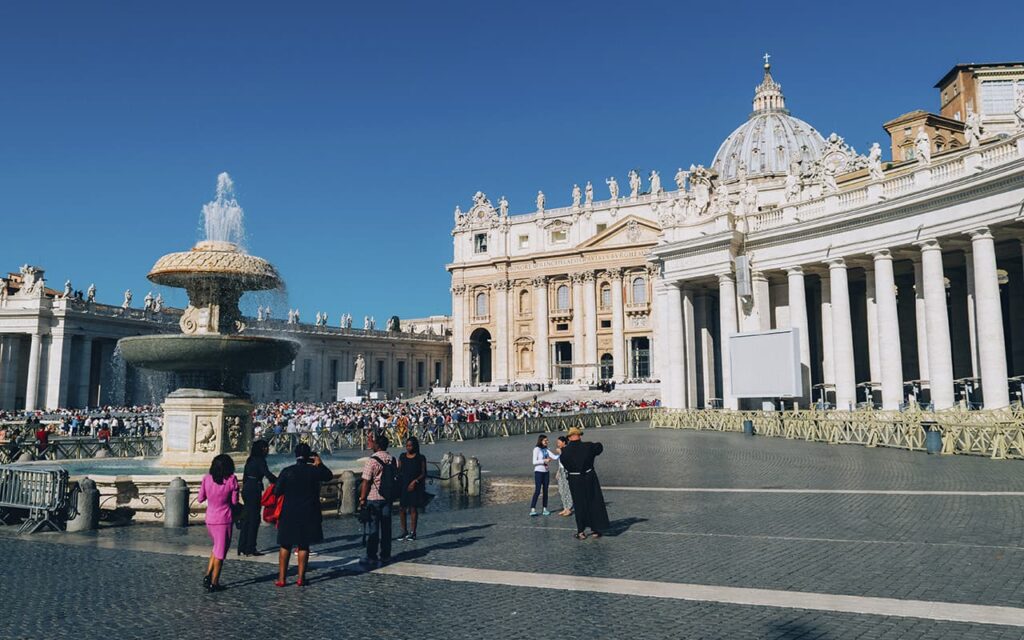The Vatican is the smallest state in the world, founded in 1929. Despite its dwarf size, the Vatican is a serious force in religious and cultural terms.
The Vatican does not have its own official language. Documents are most often published in Italian and Latin, and people speak English, Italian, French, German, Spanish, and other languages.
The Vatican is an enclave state: it is completely located within the territory of another country, Italy. The Vatican, despite its tiny size, has everything that is usually associated with the concept of a state: its own army, postal and telegraph services, its own postage stamps, its own radio station, mint, national flag, and even a small prison, which, however, has been empty for years.
On the territory of 0.44 km² there is perhaps the richest collection of works of art in the world. Its palaces, libraries, and archives contain books, documents, and works of art whose value to humanity is expressed not so much in monetary terms as in cultural and historical terms. Michelangelo’s wall frescoes in the Sistine Chapel, depicting the Last Judgment, are among the most impressive works of Western art.
One of the most magnificent churches in the Vatican is St. Peter’s Basilica. This temple really impresses with its beauty, sculptures, altars, statues, tombstones, wall paintings, size and architecture.
St. Peter’s Basilica is the largest building in the Vatican and one of the largest Christian churches in the world. It is among the ten tallest churches in the world. The construction lasted 120 years. A huge 136-meter dome rises above the cathedral, and it is one of the symbols of Rome.
The Vatican Library is one of the richest book collections in the world. It houses the largest collection of manuscripts from the Middle Ages and the Renaissance. The library’s funds include about 1.6 million printed books and 150 thousand manuscripts. Only the Vatican has a collection of such value and scope. There is also a secret archive where personal collections and royal collections are kept. In total, the library has 13 halls, each of which has its own funds, and there is also the Biblioteca segreta archive, which contains especially valuable and classified documents. Only the Pope has access to some of them.
In June 1475, the opening of the Vatican Library was documented. However, the collection of books and the creation of archives began much earlier, in the fourth century.
The library also owns a laboratory for the restoration of ancient documents and manuscripts and a School of Librarians.
The Vatican authorities have digitized their entire library and provided free access to everyone.
The Vatican is the only state that is fully on the UNESCO list. Given its high historical value and cultural significance.
There are no traffic lights in this country. And 95% of Vatican City residents are men.
The Vatican is home to the world’s oldest pharmacy, founded in 1277. It sells rare medicines that are not always found in Italy.
The Vatican is a vast complex that has been built over the centuries and has been the residence of the Popes since 1377.
However, the main treasure of the Vatican is its museums. They include a complex of unique buildings and the most valuable collections of antiquities.
The Gregorian Etruscan Museum, located in the palace of Innocent VIII, has 18 halls. It presents household items of ancient settlements from the early Bronze Age, which is the 9th-8th centuries BC. Each hall tells a story in chronological order, demonstrating frescoes, ivory, statues and luxurious dishes.
The Historical Museum is extremely interesting. A collection of carriages, cars, and various paraphernalia that can be used to trace the history of the Vatican. There is also a collection of contemporary church art, galleries of ethnographic maps, candelabra, and a chariot hall.
The Vatican museums are a step into history, religion, and art, revealing the unknown secrets of the past.
